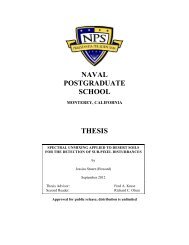October 2000 Newsletter - Naval Postgraduate School
October 2000 Newsletter - Naval Postgraduate School
October 2000 Newsletter - Naval Postgraduate School
Create successful ePaper yourself
Turn your PDF publications into a flip-book with our unique Google optimized e-Paper software.
Introduction<br />
In general terms, weaponeering can be defined as the process<br />
of determining the quantity of a specific type of weapon<br />
required to achieve a specific level of target damage, considering<br />
target vulnerability, weapon effects, munition delivery<br />
errors, damage criteria, probability of kill, weapon reliability,<br />
etc. In the operational arena, where planners are striving for<br />
the most effective use of limited resources, efficiency is a<br />
critical factor that must be considered in the weaponeering<br />
process. Commanders want to use their weapons systems to<br />
inflict maximum damage on enemy plans, forces, and facilities.<br />
Under these conditions weaponeering is probably best<br />
defined as the process of determining the minimum-force<br />
level and optimum ordnance needed to achieve a desired level<br />
of damage to a target or critical component, such that enemy<br />
warfighting is affected.<br />
History of the Joint Technical Coordinating Group for<br />
Munitions Effectiveness (JTCG/ME)<br />
In 1963, an Army-Air Force panel known as the Close Air<br />
Support Board issued a report calling attention to large gaps<br />
and gross inaccuracies in data then published on air-to-surface<br />
non-nuclear munitions. To remedy these inconsistencies, the<br />
board recommended production of a joint service publication<br />
containing a comprehensive list of targets with corresponding<br />
data on the effectiveness of aerially delivered munitions<br />
suitable for defeating those targets. Responding to this<br />
challenge, the Joint Chiefs of Staff requested that a joint<br />
service working group correct the data deficiencies and<br />
prepare a Joint Munitions Effectiveness Manual (JMEM) for<br />
air-to-surface weapons. The Army was tasked to be the lead<br />
service. The Chairman of the JTCG/ME established an ad<br />
hoc group of military and civilian scientists scattered through<br />
the Defense Department. The group developed the first<br />
standardized methodology for evaluating weapons, and this<br />
product was a coordination draft of a multi-service manual<br />
entitled Joint Munitions Effectiveness Manual for Air-Delivered<br />
Non-nuclear Weapons. This manual was accepted not only by<br />
the scientists and military professionals but also by the<br />
Secretary of Defense. The latter requested that a similar<br />
approach be applied to surface-to-surface weapons.<br />
In the fall of 1965 the original ad hoc group was given<br />
formal status as the Joint Technical Coordinating Group for<br />
Munitions Effectiveness (JTCG/ME) by the Joint Logistics<br />
Commanders. By mid-1966, the JTCG/ME was supported<br />
by three working groups: Target Vulnerability, Chemical and<br />
RESEARCH AND EDUCATION<br />
WEAPONEERING: FROM A JTCG/ME PERSPECTIVE<br />
Biological, and the original Air-to-Surface (JMEM/AS)<br />
Group. These working groups, in turn, controlled the activities<br />
of subgroups created and tailored for specific aspects of<br />
the parent group’s mission. The JMEM/AS had subgroups for<br />
weapon characteristics, delivery accuracy, flame and incendiary<br />
effects, methodology, and publications. A separate Basic<br />
Manual Working Group, chaired by the Defense Intelligence<br />
Agency, was established to maintain the Weapon Effectiveness,<br />
Selection, and Requirements - Basic JMEM/AS Manual. In<br />
January 1967, JTCG/ME brought in a JMEM Production<br />
Contractor to provide support for the development and<br />
production of technical handbooks, JMEMs, special reports,<br />
and related publications.<br />
By 1967, the JTCG/ME was concerned not only with<br />
deriving or validating data by tests, experiments, and mathematical<br />
models, but also from direct inputs of data from the<br />
battlefield. The JTCG/ME Wound Data and Munitions<br />
Effectiveness Team gathered wound data from Southeast Asia<br />
(SEA). Later, the team expanded the scope of its battlefield<br />
collection to include materiel and sent specialized teams to<br />
SEA under an effort labeled BDARP-Battle Damage Assessment<br />
and Reporting Program. These data are currently stored<br />
in the Survivability/Vulnerability Information Analysis Center<br />
(SURVIAC) at Wright-Patterson AFB and are available for<br />
study and research by DoD agencies and contractors.<br />
In September 1967, a separate major group, JMEM/SS,<br />
was created to examine and produce data on surface-tosurface<br />
munitions. Manuals containing data on individual<br />
surface-to-surface weapons were published and revised as new<br />
targets or munitions were developed. To complete the<br />
weapon-target interface the JTCG/ME established the Anti-<br />
Air Working Group in 1976. Additionally, a Red-on-Blue<br />
Working Group was formed in 1977 to address the effectiveness<br />
of Red munitions on Blue targets. A Special Operations<br />
Working Group, initiated in 1983, provided target vulnerability<br />
and weapon effectiveness studies for Special Forces. In<br />
1994, the JTCG/ME was reorganized with four major<br />
working groups: Air-to-Surface, Surface-to-Surface, Anti-Air,<br />
and Vulnerability (including Special Operations) to cover the<br />
spectrum of weapon effects issues. In addition, each working<br />
group is supported by a formally chartered Operational Users<br />
Working Group (OUWG). The Central Office is the focal<br />
point for all JTCG/ME efforts. They coordinate the efforts of<br />
the working groups while the execution of those efforts is the<br />
responsibility of the working group chairmen.<br />
--continued on page 11<br />
NPS Research page 10<br />
<strong>October</strong> <strong>2000</strong>
















